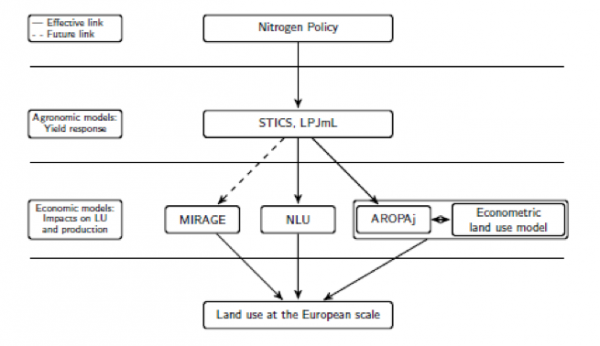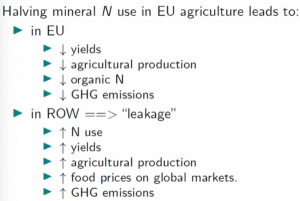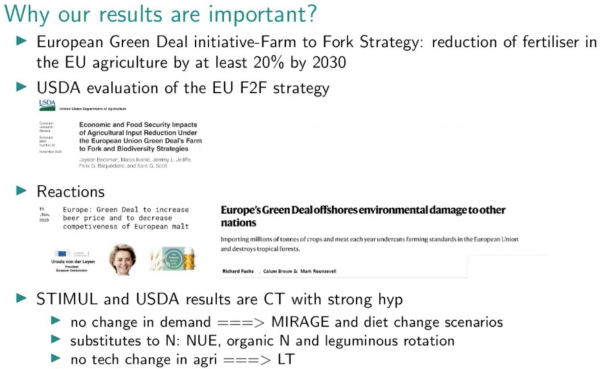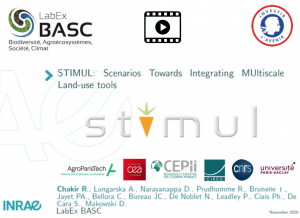Project title: Scenario towards multi-scale integration of land use models (STIMUL for short)
Type of project: flagship project (2016-2019) of LabEx BASC
Leaders: Raja CHAKIR and Jean-Christophe BUREAU (Economie Publique)
Partners:
- In BASC: Agronomie, CIRED (International Center for Research on Environment and Development), ESE (Ecology, Systematics, Evolution), LSCE (Laboratory of Climate and Environmental Sciences)
- Non-academics: CEPII (Centre for Prospective Studies and International Information)
The intensive use of nitrogen fertilizers in agriculture is a major contributor to GHG emissions, air quality degradation and eutrophication of water bodies. The objective of the STIMUL project was to assess the impacts of a 50% reduction in the use of mineral nitrogen fertilizers in European agriculture. This is a complex problem, because of the induced and indirect effects. Thus, it is necessary to take into account the agronomic impacts (yields), but also the direct and indirect changes in land use, the impact on agricultural production and on ecosystems. Understanding these effects and their complex interactions is essential to design public policies to preserve the environment that would avoid undesirable and unforeseen effects. In particular, this will show that policies that have local environmental benefits (e.g., extensification of agricultural practices) can have indirect effects on land use that spill over to markets and countries through effects on world prices (i.e., "leakage").
To answer this question, we have mobilized a set of economic, agronomic and biophysical models to analyze the impacts of halving mineral nitrogen use in EU agriculture on land use change in the EU and globally and to assess the agricultural, economic, carbon and biodiversity consequences. This analysis is structured around a soft coupling of agronomic models (STICS and LPJmL), economic models (MIRAGE, AROPAj, NLU, econometric land use model). These models differ in their methodologies, scale of interest and resolution, but they are very complementary and are all relevant for a complete analysis of the impacts of halving mineral nitrogen in Europe in terms of direct and indirect changes in land use. The land uses predicted by the economic models are used to simulate the impact on biodiversity via the PREDICTS model and on carbon via the ORCHIDEE model of the scenario studied.
Project beneficiaries:
- Public decision-makers who are wondering about the possibilities of adaptation of the European agricultural sector in the framework of the Green Deal and in particular the "Farm to Fork" strategy, which foresees a significant decrease in nitrogen fertilization by 2030: Ministry of Agriculture, European Commission, European Parliament
- Scientists who seek to coordinate different approaches within the framework of integrated modeling of the ecological transition
- The agricultural development community, which is wondering about the effects of nitrogen leakage reduction strategies (Nitrates Directive) and the effects of current policies (Green Deal) on harvests and income (agricultural council, chambers of agriculture, regions, cooperatives).
The use of mineral nitrogen in agriculture has allowed a tremendous gain in productivity that today feeds almost half the world's population (Erisman et al., 2008[1], Smil, 2002[2]). However, this comes at a rather high environmental price and threatens the sustainability of agriculture. A change in current practices will inevitably be linked to changes in land allocation and these have until recently been the most important driver of biodiversity loss, particularly through habitat degradation (Foley, 2005[3]).
One of the strengths of the project is to mobilize a set of economic, agricultural and biodiversity models allowing us to cover the local and global scale of the impacts of halving nitrogen use in Europe and to integrate the effects on the rest of the world via indirect land use changes.
Main results :
At the European level, our results show that a 50% reduction in the use of nitrogen fertilizer in European agriculture will reduce yields and agricultural production. An interesting result shows that the use of livestock manure will also decrease due to the extensification of livestock farming and the increase in the price of fodder crops. Thus, greenhouse gas emissions from agriculture in Europe are decreasing. The impacts on carbon and biodiversity are mixed between models.
In the rest of the world and via indirect soil changes, our results show that agricultural production will increase as well as the use of nitrogen fertilizers. World prices will also increase as well as greenhouse gas emissions exceeding the reduction obtained in the EU. However, we do not assess the gains in terms of air and water quality.
These results should be interpreted with caution, as our models do not take into account structural changes, such as the responses in terms of technological innovations that may emerge in the event of a restriction in the use of synthetic nitrogen fertilizers. Our results also do not take into account possible adjustments on the demand side, particularly in terms of changes in diet towards less meat consumption.
To broaden the analysis, a first perspective is to evaluate the impact of the proposed policy on water quality. In addition, the work undertaken in the framework of the STIMUL project has allowed the establishment of a reinforced dialogue between the teams of the different partner laboratories, which opens the perspective towards other collaborations in the future.
Footnotes:
[1] Erisman, J. W., Sutton, M. A., Galloway, J., Klimont, Z., and Winiwarter, W. (2008). How a century of ammonia synthesis changed the world. Nature Geoscience, 1:636.
[2] Smil, V. (2002). Eating Meat: Evolution, Patterns, and Consequences. Population and Development Review, 28(4), 599–639.
[3] Foley, J. A. (2005). Global Consequences of Land Use. Science, 309(5734), 570–574.
===> The project leader explains her RESULTS in VIDEO
(LabEx BASC Scientific Days, November, 2020)
To learn more, visit the project website.
Publications
Here is the list of scientific productions associated with the STIMUL project:
- Bayramoglu, B., Chakir, R. & Lungarska, "Impacts of Land Use and Climate Change on Freshwater Ecosystems in France" Environmental Modeling and Assessment (2019). https://doi.org/10.1007/s10666-019-09673-x **
- Damien Beillouin, Tamara Ben-Ari, David Makowski 2019 "A dataset of meta-analyses on crop diversification at the global scale" Data in Brief, Volume 24. https://doi.org/10.1016/j.dib.2019.103898
- J. Vaitkeviciute, R Chakir, S Van Passel (2019) "Climate variable choice in Ricardian studies on European agriculture". Revue Economique. vol 70. https://www.cairn.info/revue-economique-2019-3-page-375.htm# **
- ALBERT, Isabelle and MAKOWSKI, David. (2018) "Ranking crop species using mixed treatment comparisons". Research Synthesis Methods. https://doi.org/10.1002/jrsm.1328
- Lungarska, A. & Chakir, R. (2018), 'Climate induced land use change in France: impacts of agricultural adaptation and climate change mitigation', Ecological Economics 147 , 134--154.
- Cernay C., Makowski D., Pelzer E. (2018). New Insights into the Yieldsof Underexploited Grain LegumeSpecies: Waste Recycling and Fertilisation in Lichtfouse E. (Ed.), Sustainable Agriculture Reviews 32, pp.77-103. doi: 10.1007/978-3-319-98914-3_4**
- Cernay, C.; Makowski, D. & Pelzer, E. (2017), 'Preceding cultivation of grain legumes increases cereal yields under low nitrogen input conditions', Environmental Chemistry Letters, 1--6.
- Lesur-Dumoulin, C.; Malézieux, E.; Ben-Ari, T.; Langlais, C. & Makowski, D. (2017), 'Lower average yields but similar yield variability in organic versus conventional horticulture. A meta-analysis', Agronomy for Sustainable Development 37(5), 45.
Presentations at conferences
- A. Lungarska, R. Chakir et P.-A. Jayet. (2018) “Input taxation at different spatial scales : reducing nitrogen fertilizer use in Europe” 6th World Congress of Environmental and Resource Economists, Gothenburg, Sweden, June.
- Bayramoglu, R. Chakir, A. Lungarska: 'Land use and freshwater ecosystems in France' presented at the 18th Annual BIOECON Conference, Cambridge, septembre 2016. Conference EcoMod, Lisbonne, juillet 2016. The 23rd Annual Conference of the European Association of Environmental and Resource Economists (EAERE), juin-juillet 2017, Athènes, Grèce. And at the XV EAAE Congress, août 2017, Parme, Italie
- Rémi Prudhomme , Thierry Brunelle, Patrice Dumas, Xin Zhang. (2017): 'Legumes production in Europe to mitigate agricultural emissions in a global perspective' Présenté à la conférence de la FAERE (French Association of Environmental and Resource Economists)
Working papers
- Bayramoglu, R. Chakir, A. Lungarska (2018): 'Land use and freshwater ecosystems in France' submitted
- Jayet and Ollier (2018): 'Economic tools aiming at nitrogen use reduction by the European agro-system', working paper
- Lungarska, Chakir and Jayet (2018) : 'Input taxation at different spatial scales: reducing nitrogen fertilizer use in Europe' working paper
For more information






